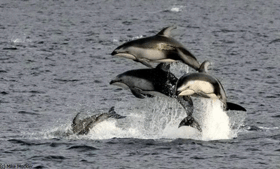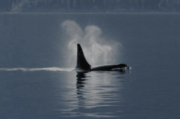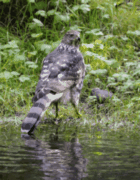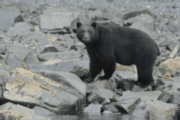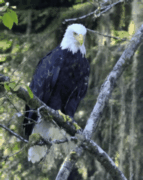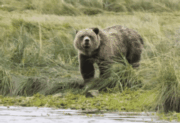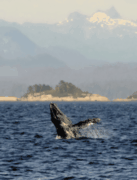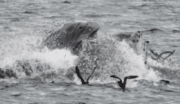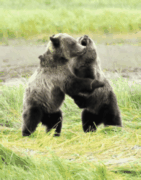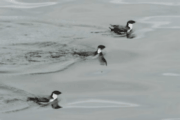Mike Mockler Canada -
Vancouver & Vancouver Island
|
WHALES, ORCAS, DOLPHINS AND BEARS Vancouver, with its vibrant waterfront and friendly atmosphere, provided a good start to the Canada tour. Raccoons and Harbour Seals were among early mammal sightings and Stanley Park provided enjoyable bird-watching: Cooper’s Hawk, Wood Duck, Blue-winged Teal, Pileated Woodpecker, Brown Creeper, Chestnut-backed Chickadee and Red-breasted Nuthatch all provided good views. However, it was soon time to move on. Vancouver Island, where eight days would be spent afloat, was the next stop and much bigger creatures were in prospect there. Two day-long “Grizzly Bear” boat excursions out from northern Vancouver Island, produced the first of many close encounters with Humpback Whales (one surfaced without warning almost under the bow of the small motorboat), good views of Mule Deer, many new birds and several hours in the company of Grizzly Bears, notably a mother and two playful cubs. Disappointingly, salmon numbers were such that no bears were seen fishing. Yet still the main event lay ahead. Mike’s research indicated that the best whale-watching was to be had around Telegraph Cove in Johnstone Strait, while good friends Ralph and Brenda Todd suggested that the best people to go with were Jim and Mary Borrowman. This proved to be excellent advice: the Borrowmans had been the first to establish a whale-watching company in British Columbia and had set the standard in the industry ever since. Today they operate what they call multi-day expeditions under the name Orcella Expeditions. And so it was that Mike and his wife, Pat, set off from Telegraph Cove for 6 days and 6 nights aboard the delightful little Gikumi, an historic old tugboat lovingly and sensitively restored by the Borrowmans. What followed was a truly memorable experience with a wealth of highlights. In fact, it’s hard to imagine a more personalised expedition. Just 6 passengers (which represents a full quota) were the beneficiaries of the Borrowmans’ remarkable local knowledge, experience and hospitality – which includes Mary’s exceptional cooking. The weather was kind for most of the time and sea conditions varied between flat-calm and mirror-like tranquillity. The sun shone on most days, except in the early mornings when fog created some fabulous atmospheric scenes. Johnstone Strait is renowned for its Orcas and resident Orca pods were seen daily, sometimes several times a day. At times, the Orcas indulged in a variety of activities including spy-hopping, tail-slapping and breaching. On occasions, they passed the boat so close that their calls were audible. Then, when Jim lowered a hydrophone into the water, it was possible to listen in to their complex conversations. Jim explained that each Orca population has its own “dialect” and that transient Orcas sound quite different from the resident pods. Humpback Whales were seen equally frequently and, at times, there were 10 - 12 of them in the immediate vicinity of the boat. Surprisingly, they were even more active than the Orcas. Frequently surfacing close to the boat with loud exhalations, they entertained with breaching, tail-slapping, fluking and loud, elephant-like, bellowing. Most spectacular of all was so-called “lunge-feeding” whereby the whale surges to the surface, mouth wide open, to engulf shoals of herring. Often, hundreds of herring spilled from the whale’s enormous gape. Despite the wonderful encounters with Orcas and Humpbacks, probably the most joyous moments of the entire trip involved Pacific White-sided Dolphins which are dynamic, exquisitely marked creatures. As the Gikumi steamed along, an amazing sight slowly presented itself ahead: the surface of the water seemed to be boiling. Closer inspection revealed some 500-600 of these exuberant dolphins racing across the surface and leaping high into the air. Sometimes groups of 3 or 4 leapt out of the water in unison, as though rehearsing for a synchronised Olympic event. But why were they doing this? One can only guess but it appeared to be simply for the sheer joy of it. Black Bears were seen on several days, usually beach-combing for crabs hidden beneath stones and rocks. Jim took the Gikumi as close to the shore as possible for closer views and photographs. One early morning, when a Black Bear was seen pottering around on a rocky shore, Jim launched the little skiff which was towed behind the Gikumi and drifted so close to the shore that it was possible to count the hairs on the bear’s face. Other mammals recorded were Steller’s Sea-Lion, Harbour Seal, Harbour Porpoise, Dall’s Porpoise, River Otter and American Mink. Birdlife was always interesting, ranging from the ubiquitous Bald Eagle to Eurasian Collared Dove which is now establishing itself in the far north of Vancouver Island. Other birds included Osprey, American Kestrel, Steller’s Jay, Cedar Waxwing, Fox Sparrow, Red Crossbill and a huge juvenile Peregrine which was so big it looked more like a Gyrfalcon. Not surprisingly there were plenty of seabirds and waterbirds. Harlequin Ducks, White-winged Scoters and Surf Scoters were often seen flying in long lines just above the water. Other regular sightings included Common Loon, Pacific Loon, Western Grebe, Red-necked Grebe, Black Turnstone, Red-necked Phalarope, Rhinoceros Auklet, Common Murre, Ancient Murrelet, Sooty Shearwater and several species of gulls, the identification of which was sometimes quite a challenge. All in all, it was an unforgettable wildlife experience, made extra special by Jim, Mary and, of course, the Gikumi.
|
